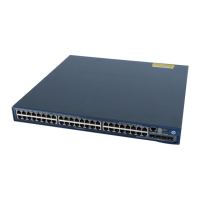82
Configuring the Digest Snooping feature
You can enable Digest Snooping only on a device that is connected to a third-party device that uses its
private key to calculate the configuration digest.
Follow these steps to configure Digest Snooping:
Enter interface
view or port
group view
Enter Ethernet
interface view or
Layer 2 aggregate
interface view
interface interface-type interface-
number
Required
Use either command.
port-group manual port-group-
name
Enable Digest Snooping on the interface
or port group
stp config-digest-snooping
Required
Disabled by default.
Enable global Digest Snooping
stp config-digest-snooping
Required
Disabled by default.
CAUTION:
With digest snooping enabled, in-the-same-region verification does not require comparison of configuration
digest, so the VLAN-to-instance mappings must be the same on associated ports.
With global Digest Snooping enabled, modification of VLAN-to-instance mappings and removal of the current
region configuration via the undo stp region-configuration command are not allowed. You can modify only the
region name and revision level.
To make Digest Snooping take effect, you must enable Digest Snooping both globally and on associated ports.
HP recommends that you enable Digest Snooping on all associated ports first and then enable it globally. This
will make the configuration take effect on all configured ports and reduce impact on the network.
To avoid loops, do not enable Digest Snooping on MST region edge ports.
HP recommends that you enable Digest Snooping first and then MSTP. To avoid causing traffic interruption, do
not configure Digest Snooping when the network is already working well.
Digest Snooping configuration example
1. Network requirements
As shown in Figure 21:
Device A and Device B connect to Device C, which is a third-party device. All these devices are in
the same region.
Enable Digest Snooping on the ports of Device A and Device B that connect Device C, so that the
three devices can communicate with one another.

